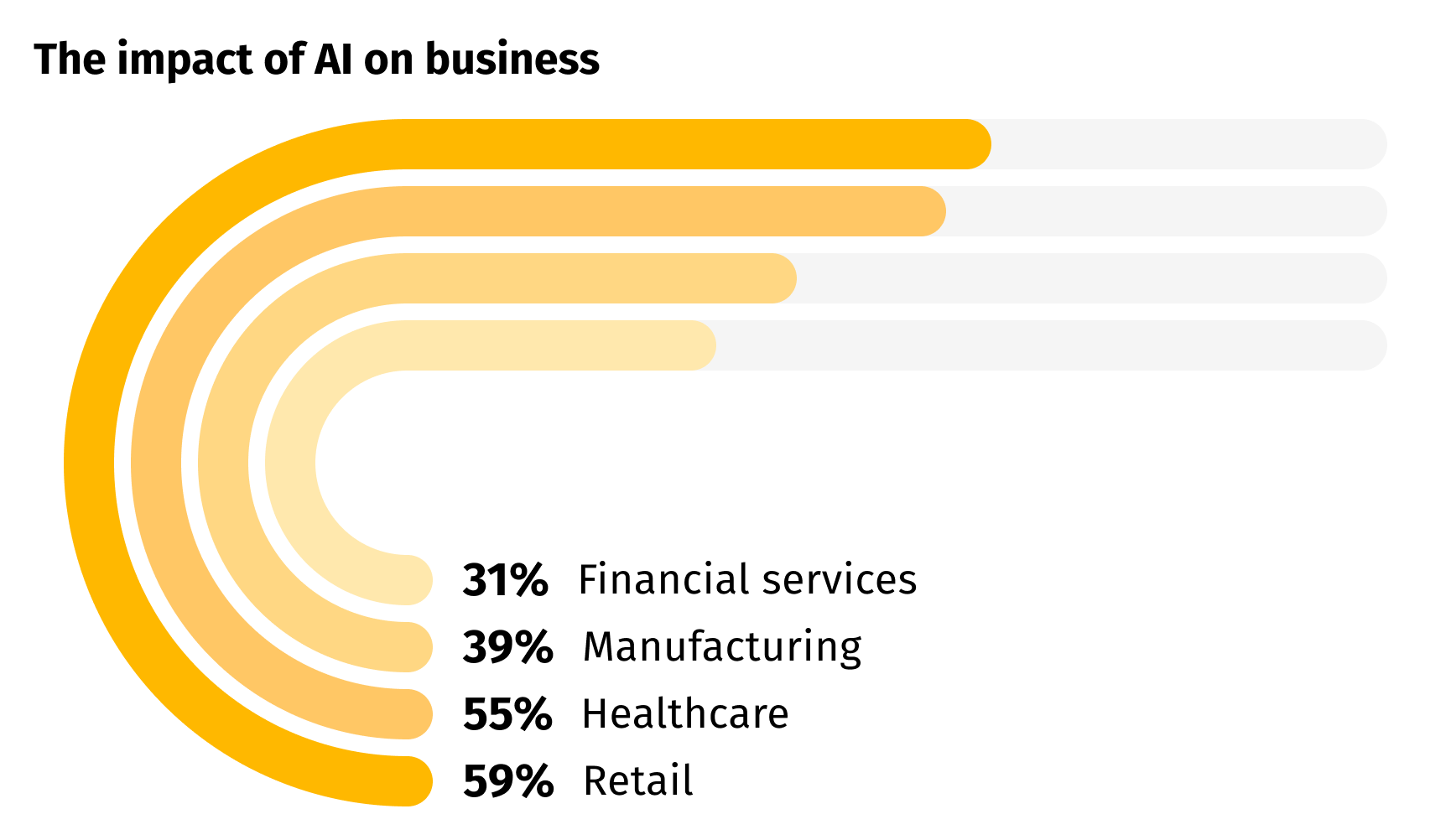
The real value of AI: Get tangible ROI in 2023
Over the past few decades, Artificial Intelligence (AI) made a huge leap from a fancy buzzword out of the science fiction realm to a powerful technology that is virtually reshaping our reality. What was once perceived as a figment of our futuristic imaginations is now a fundamental part of our everyday lives.
Tech giants like Google, Microsoft, AWS, IBM, and Grid Dynamics, place AI at the core of their operations, motivating greater and more innovative efficiencies. Smaller enterprises and budding startups are following their lead, using the benefits of AI to fuel their business growth.
As more and more organizations embrace this technology to boost their performance and optimize functionalities, the role of artificial intelligence in value creation is also rising. In this blog, we will talk about the economic impact of AI across industries and some ways to balance the financial equation of expenses and ROI.
4 ways to prove ROI from AI investment
The hype around artificial intelligence is hard to ignore. This technology is transforming the way we live, work, and do business in the 21st century, becoming increasingly front of mind with organizations across various industry domains. In fact, according to an estimation made by PwC, the implementation of AI-based solutions at a mass scale can contribute as much as $15.7 trillion to the world economy by 2030, leading to a 14% growth of global GDP. While the prominence of artificial intelligence as a new production factor is just getting started, a lot of companies are already capitalizing on AI opportunities. IBM’s survey, The business value of AI, states that enterprises embracing AI at least in the pilot stage outperform their competitors 2X financially. They also see on average up to 6% direct gains from their AI investments. At the same time, organizations that have already advanced to operating and/or optimizing phases claim twice as much ROI, which translates to a 10-12% revenue boost.The economic benefits of AI are mainly driven by productivity gains spurred by augmenting the existing labor force, automating decision-making, optimizing business processes, and improving customer service. Let’s take a closer look at the advantages of artificial intelligence:
Augmenting human capacity
Thanks to AI advancements, machines are now able to better understand and even anticipate what users want, starting a new chapter in human-machine interaction. Moreover, AI technologies can be designed and combined in such a way that enables them to sense, comprehend, and learn from human behavior. This opens staggering possibilities for labor productivity augmentation through:
- Efficient use of manpower. Employees can delegate mundane, low-value-added tasks to AI and direct their newly available manual and cognitive capacities to more sophisticated activities.
- Assisted intelligence. As workers and machines collaborate more closely, AI algorithms can optimize existing tasks and adjust the current workload based on human feedback.
- Eradicating human error. AI systems can discover, source, and structure data both inside and outside the organization providing high-quality insights into every stage of the product life cycle. This way, technologies can aid people in making decisions or taking action, enabling them to perform their tasks faster and better.
- Addressing skill and labor shortages. AI helps businesses to upskill their workforce on time and within budget. AI-based tools combine institutional knowledge, historic data, and information from clients and vendors to create training materials that enable employees to master required competencies more effectively than traditional onboarding methods.
Automating decision-making
In today’s fast-paced business environment, companies have to make millions of real-time micro-decisions about every customer, product, supplier, asset, or transaction. The adoption of artificial intelligence empowers organizations to automate these processes, leading to improved consistency and efficiency, reduced costs, and the emergence of new innovative solutions to complex problems.
Based on the level and nature of the human intervention, the degree of AI involvement in the decision-making process may be different. It can vary from intelligence amplification, where machines provide only decision support or partial automation of some tasks, to full-scale AI control with all the decisions made through purely technological means with no humans in the loop.Boosting operational efficiency
AI can create a game-changing shift in corporate productivity. In a survey done by PwC, 54% of executives claim that artificial intelligence is already driving more efficient business processes and daily operations. These improvements are expected to account for over 55% of all GDP gains from AI by 2030. A large portion of companies that deploy AI apply it to automate processes too complex for older technologies. One of the top use cases, favored by nearly one-third of organizations, is Artificial Intelligence for IT Operations (AIOps). This technique employs big data, machine learning and advanced analytics technologies to enhance IT operations, preserving application performance and making resource allocation more efficient. According to IBM Global AI Adoption Index 2022, the positive effects of AI-fueled automation can also be seen in areas like security and threat detection (29%), business process automation (28%), business analytics or intelligence (26%), and fraud detection (23%).
Improving customer engagement
Companies across all industries are putting personalized and seamless omnichannel experiences at the heart of their enterprise strategies. One area where AI can add value is the ability to capture, analyze, and utilize customer information across multiple touchpoints, data sources, and operations to better navigate the consumer landscape.
Brands can use all this information to shape, modify, and optimize the customer journey by tapping into consumer preferences, understanding sales drivers, and anticipating client needs and trends. This enables organizations to tailor their output to match these individual demands, especially in their messaging, personalization, and delivery of the user experience.
Around 40% of companies are currently using AI to improve customer service and better equip their agents to provide tailored, precise, and empathetic care. As technology matures, artificial intelligence is poised to play an even bigger role. According to Servion Global Solutions, AI will power 95% of all customer interactions by 2025. And while online chats and virtual assistants are already seeing a boom in popularity, future tech advancements will leave customers unable to spot the bot, leading to frictionless interactions and streamlined services.Realizing the potential of AI: industry spotlight
As one of the most significant technological advancements in recent years, AI serves as a catalyst for innovation, growth, and business transformations. The positive impacts of artificial intelligence are markedly felt across retail, manufacturing, healthcare, and financial services. These are also the industries with the largest spending amounts, representing nearly 55% of global AI investment, which are going to surpass $300 billion by 2026, according to IDC.
But how are AI investments driving returns? Here are just some of the ways artificial intelligence can help businesses:
AI for retail
AI is a tech powerhouse of digital commerce evolution. This technology permeates every aspect of retail operations from routine organizational tasks such as supply chain execution and inventory management to cutting-edge issues like customer personalization and immersive shopping experiences. Through the adoption of artificial intelligence business solutions, the retail industry can yield more than $2 trillion in GVA by 2035, an increase of 36% compared to business-as-usual value.
Here are just some of the digital commerce capabilities powered by AI technology:
- Search. AI-centered systems are an underlying technology behind marketplace search, which enabled e-commerce giants like Amazon to push the bounds of innovation and introduce unique management strategies, expanding their business.
- Product recommendations. By combining deep learning, visual similarity technology, and personalization algorithms, AI can accurately capture customer shopping intent and provide relevant recommendations that anticipate their wants concerning fashion and style.
- Virtual assistant. Conversational AI can engage clients at every step of their shopping journey, from product discovery and selection to checkout and post-purchase support, enabling retail brands to deliver intelligent, personalized customer experiences, while increasing conversion rates and boosting the average order value.
AI for manufacturing
Artificial intelligence combined with other tech advancements such as IoT, cloud computing, big data analytics, smart sensors, 3D printing, and robotics, are transforming manufacturing into a single cyber-physical system that binds together workpieces, machines, and people to create an autonomous production process. This could bring an additional $3.8 trillion GVA in 2035 to this sector, which translates to around a 45% increase compared with the baseline case.
The areas with the biggest AI potential in the manufacturing industry are:
- Quality control. AI algorithms can perform visual quality inspection of assembly lines, workflows, and products to ensure stronger quality control, fewer errors, and faster response. Anomaly detection algorithms can also detect potential production flaws related to deviations from standard procedures, anomalies in machine behavior, and changes in raw materials, making the manufacturing process more predictable and controllable.
- Maintenance. Modern predictive maintenance AI solutions allow for intelligent monitoring of machine health, ensuring timely maintenance, near-zero downtime, and even auto-correction of manufacturing processes.
- Production optimization. AI helps businesses to handle line balancing, product design and development, process parameter optimization, and production planning issues to enable flexible, responsive, and efficient manufacturing of goods.
- Supply chain monitoring. AI supply chain optimization solutions can be used for future demand and price forecasting, supply chain control tower, and warranty and service management.
AI for healthcare and pharma
Today, artificial intelligence is applied to a wide range of healthcare services, from safeguarding private records and a virtual nurse to personalized medicine and robot-assisted surgeries. Due to the rising potential of this technology, the market value of AI in the healthcare industry can reach up to \$95.65 billion by 2028, representing an almost 15-fold increase from 2021 when the revenue gain amounted to \$6.6 billion. AI-fueled innovations in the medical field are also expected to generate \$461 billion of additional GVA by 2035.
The projected economic impact is primarily driven by potential applications of AI technology in genomics and drug discovery. However, there are other fields where artificial intelligence can prove to be useful:
- Diagnostics support. With the increasing number of AI-powered wellness devices, healthcare professionals don’t rely solely on people reporting their personal health data. Smart health monitoring systems can paint a comprehensive picture of a patient's daily life, by tracking their vital signs, from heart rate, blood pressure and oxygen levels, to steps taken and calories burned. Since these devices have the capability to collect and process data over a longer time, they can detect even the slightest variations in the user’s conditions, allowing for faster, more accurate diagnosis, and earlier intervention.
- Medication management. AI technology can be leveraged to analyze structured and unstructured data related to the patient’s health to predict their response to certain drugs and identify the most efficient treatment plan.
- Medical implants. The dynamic adoption of AI gave rise to biomedical engineering, a field at the junction of healthcare, manufacturing, and design. This collaboration resulted in the creation of cutting-edge implant modeling techniques that can print 3D replicas of human anatomy using biocompatible materials. The ability to produce intelligent implants at scale empowers a more customized approach to patient care, reconstructive surgery, and organ transplantology.
- Commercial pharma marketing engagement. AI-powered Next Best Action analytics empower pharma sales representatives with deep insight into healthcare providers’ marketing preferences to improve engagement opportunities and drug sales conversions.
AI for financial services
When it comes to the adoption of next-gen technologies, the financial industry is usually ahead of the rest. The reason behind this is that the finance sector has a constant need for the most precise forms of computing systems to manage data assets, process business intelligence in large volumes, and consistently turn unstructured information into actionable insights.
AI is perfect for these jobs. Moreover, it can relieve financial consultants, insurance agents, and bank managers from mundane, repetitive tasks, such as generic customer queries, claim processing, and market research, as well as provide assistance in areas like:
- Personalized financial planning. AI developments such as robo-advice can analyze customers’ data, such as demographics, medical history, socioeconomic status, common transactions, and digital engagement to create more customized and holistic offers aligned with the client’s long-term needs and objectives.
- Fraud detection. AI-powered data quality tools can analyze various data points, monitor suspicious activity, and flag transactions that don’t fit normal patterns, enabling financial institutions to detect and prevent fraud attempts, eliminate policy duplication, and prohibit incorrect customer identification.
- Trading. Since AI and ML-based systems can process huge amounts of data within a short time frame, they can be used for tracing market drivers, predicting stock behavior, and handling major trading transactions. In fact, according to a J.P. Morgan study, the business value of AI in e-trading is expected to reach $19 billion by 2024.
Summary
The breadth and depth of artificial intelligence applications demonstrate that this technology has the potential to revolutionize the way we do business in the 21st century. The sooner businesses realize AI potential, investigate its capabilities, and apply it in their daily operations, the better they will be equipped for the future.
Get in touch if you want to transform your company into an AI-first organization, and achieve proven results and a quantifiable ROI.
